Marsh Life
About the Marsh
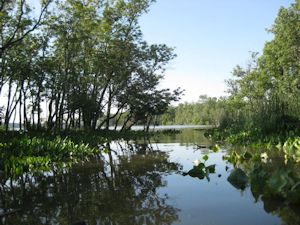 A Dyke Marsh inlet. Photo by Ned Stone.The Dyke Marsh Wildlife Preserve is a 485-acre freshwater, tidal wetland complex just south of Alexandria, Virginia, in Fairfax County, Virginia, on the western shoreline of the Potomac River around 95 miles from the Chesapeake Bay. Congress added the preserve to the national park system in 1959 "so that fish and wildlife development and their preservation as wetland wildlife habitat shall be paramount." (Public Law 86-41)
A Dyke Marsh inlet. Photo by Ned Stone.The Dyke Marsh Wildlife Preserve is a 485-acre freshwater, tidal wetland complex just south of Alexandria, Virginia, in Fairfax County, Virginia, on the western shoreline of the Potomac River around 95 miles from the Chesapeake Bay. Congress added the preserve to the national park system in 1959 "so that fish and wildlife development and their preservation as wetland wildlife habitat shall be paramount." (Public Law 86-41)
Dyke Marsh is one of the largest, most significant temperate, climax, narrow-leafed cattail marshes in the national park system, a unit of the George Washington Memorial Parkway managed by the National Park Service. It has tidal wetland, swamp forest, upland forest and open water. The southern part of the marsh is at least 2,200 years old.
In the 18th and early 19th century, the marsh was called "Hell Hole Swamp." In the early 1800s, people built earthen walls around the perimeter of part of the marsh to create more "fast land," land not inundated by high tides. The "dyked" area was then used to graze livestock and to grow crops. The walls failed.
|
Why Is Dyke Marsh Significant? FODM has created a fact sheet that explains why Dyke Marsh is significant. It includes some of the rare plants and animals in the marsh. To view the flyer, click here. |
From 1940 to 1972, Smoot Sand and Gravel dredged and hauled away almost half of the marsh, destabilizing the entire system. See "The Accelerating Erosion of Dyke Marsh" and our restoration page.
| What to See in Dyke Marsh | ||
| FODM has produced four seasonal brochures to show you what is possible to see in Dyke Marsh at each time of the year. Click the links to display each one. |
|
|
Today, Dyke Marsh is one of the largest remaining, freshwater, tidal wetlands in the Washington metropolitan area, but the wetlands have diminished to under 50 acres.
Dyke Marsh is home to many species that can only survive in wetlands. Wetlands are by their nature a water-laden environment with an enormous diversity of life forms. Wetlands provide ecological services for free. For example, they mitigate flooding, buffer storms, filter pollutants and provide habitat.
Dyke Marsh is habitat for 300 known species of plants, 6,000 arthropods, 38 fish, 34 mammals, 16 reptiles, 14 amphibians, over 270 species of birds and at least 20,000 species of insects.
Dyke Marsh, a Well-Studied Marsh
 Under the sponsorship of the Friends of Dyke Marsh, ecologist and author David W. Johnston, Ph.D., (1926-2015) consolidated and summarized many studies and reports addressing Dyke Marsh and published a paper in the Virginia Journal of Science (Volume 51, Number 4, Winter 2000). This compilation is an invaluable historical record and source of data about Dyke Marsh’s ecology, flora and fauna and human interaction.
Under the sponsorship of the Friends of Dyke Marsh, ecologist and author David W. Johnston, Ph.D., (1926-2015) consolidated and summarized many studies and reports addressing Dyke Marsh and published a paper in the Virginia Journal of Science (Volume 51, Number 4, Winter 2000). This compilation is an invaluable historical record and source of data about Dyke Marsh’s ecology, flora and fauna and human interaction.
The Virginia Journal of Science has made it available online here. You can access it on our website at Johnston Study. FODM has a limited number of reprints. Email us to determine availability and briefly explain your interest in the document.
Dr. Johnston was a member of FODM’s Board of Directors. He served in the U.S. Navy, earned his Ph.D. from the University of California at Berkeley, taught ornithology and conducted research at Wake Forest University, the University of Virginia and the University of Florida. He was Ecology Director at the National Science Foundation and worked at the National Academy of Sciences. He published widely on ornithology and ecology.
Animals of the Marsh
| Mammals Seen in Dyke Marsh | |
| Virginia Oppossum (Didelphis virginiana) | |
| Northern Short-tailed Shrew (Blarina brevicauda) | |
| Eastern Mole (Scalopus aquaticus) | |
| Star-nosed Mole (Condylura cristata) | |
| Little Brown Myotis (Myotis lucifugus) | |
| Northern Red Bat (Lasiurus borealis) | |
| Hoary Bat (Lasiurus cinereus) | |
| Silver-haired Bat (Lasionycteris noctivagans) | |
| Eastern Pipistrelle (Pipistrellus subflavus) | |
| Big Brown Bat (Eptesicus fuscus) | |
| Evening Bat (Nycticeius humeralis) | |
| Eastern Cottontail (Sylvilagus floridanus) | |
| Eastern Chipmunk (Tamias striatus) | |
| Woodchuck (Marmota monax) | |
| Eastern Gray Squirrel (Sciurus carolinensis) | |
| Southern Flying Squirrel (Glaucomys volans) | |
| American Beaver (Castor canadensis) | |
| Marsh Rice Rat (Oryzomys palustris) | |
| Eastern Harvest Mouse (Reithrodontomys humulis) | |
| White-footed Mouse (Peromyscus leucopus) | |
| Deer Mouse (Peromyscus maniculatus) | |
| Eastern Woodrat (Neotoma floridana) | |
| House Mouse (Mus musculus) | |
| Norway Rat (Rattus norvegicus) | |
| Black Rat (Rattus rattus) | |
| Meadow Vole (Microtus pennsylvanicus) | |
| Common Muskrat (Ondatra zibethicus) | |
| Red Fox (Vulpes vulpes) | |
| Common Gray Fox (Urocyon cinereoargenteus) | |
| Common Raccoon (Procyon lotor) | |
| Mink (Mustela vison) | |
| Striped Skunk (Mephitis mephitis) | |
| Northern River Otter (Lutra canadensis) | |
| White-tailed Deer (Odocoileus virginianus) |
Dyke Marsh supports a diversity of animals, including gray squirrels, cottontail rabbits, shrews, field mice, river otters, red fox, little brown bats and whitetail deer. Evidence of beaver activity is often visible along the Haul Road and boardwalk. Beavers and muskrats can be seen swimming in the marsh in the early evening. Fish include carp, bullhead, chain pickerel, shad, striped bass and shiners. Reptiles such as snapping turtles and northern water snakes and amphibians such as frogs are also common. The table at right lists all the mammals observed in Dyke Marsh over more than 30 years as documented in the FODM sponsored study The Dyke Marsh Preserve Ecosystem by David W. Johnston.
Beaver Activity in Western Dyke Marsh
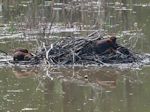 FODMer Laura Sebastianelli is monitoring beavers in the western part of Dyke Marsh, behind River Towers. On May 1, she spotted two families, two adults and a kit and two adults and two kits nursing. At one point, she saw five adults and three kits on top of the lodge (see photo) and at least one beaver swimming around. Thank you, Laura. This is a very special, little-visited part of Dyke Marsh.
FODMer Laura Sebastianelli is monitoring beavers in the western part of Dyke Marsh, behind River Towers. On May 1, she spotted two families, two adults and a kit and two adults and two kits nursing. At one point, she saw five adults and three kits on top of the lodge (see photo) and at least one beaver swimming around. Thank you, Laura. This is a very special, little-visited part of Dyke Marsh.
FODMers Learn About Frogs and Bats
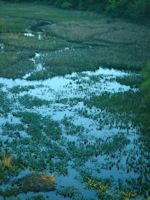 FODM member Deborah Hammer led a group of 35 on a frog and bat walk in the western part (photo, left) of the Dyke Marsh Wildlife Preserve on the evening of May 1. Deborah is a bat educator and rehabilitator. She lives nearby and has observed frogs and bats in this part of Dyke Marsh for the last 13 years. She is concerned that she is not hearing many spring peepers or seeing as many bats as she used to. “The sky used to be filled with them,” she commented.
FODM member Deborah Hammer led a group of 35 on a frog and bat walk in the western part (photo, left) of the Dyke Marsh Wildlife Preserve on the evening of May 1. Deborah is a bat educator and rehabilitator. She lives nearby and has observed frogs and bats in this part of Dyke Marsh for the last 13 years. She is concerned that she is not hearing many spring peepers or seeing as many bats as she used to. “The sky used to be filled with them,” she commented.
Deborah told the group that frogs and toads need still water like ephemeral pools upland to lay eggs and hatch tadpoles. Bats need woodland trees upland of wetlands for nesting and marsh areas for hunting for food. She is concerned that development proposed for Westgrove Park to the west of Dyke Marsh could destroy or degrade the little nearby suitable habitat that remains. “It’s all interconnected,” she commented.
She offered many interesting facts, among them these:
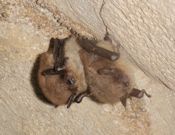 ■ The most common native frogs here are the green frog, bullfrog, spring peeper and southern leopard frog. Dyke Marsh is the southern leopard frog’s northernmost habitat.
■ The most common native frogs here are the green frog, bullfrog, spring peeper and southern leopard frog. Dyke Marsh is the southern leopard frog’s northernmost habitat.
■ Bats can live 20 years on average, are the only mammal that flies and can eat 3,000 insects a night.
■ There are 16 bat species in Virginia and 10 in Fairfax County. (Little brown bat, photo by Rick Reynolds.)
Birds
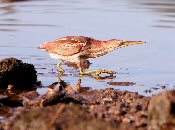 Least bittern (Ixobrychus exilis). Photo by Ed Eder.
Least bittern (Ixobrychus exilis). Photo by Ed Eder.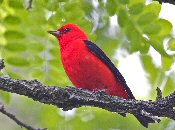 Scarlet tanager. (Piranga olivacea) Photo by Ed Eder.Birds are perhaps the most visible and accessible animal species of the marsh. Bird-watching, or birding has made the Dyke Marsh Wildlife Preserve a popular attraction for many visitors. There are resident species in every habitat from emergent wetlands to upland forests as well as migratory species that visit the marsh each spring and fall. FODM has conducted several studies and surveys on birds and bird life and has documented over 270 species in Dyke Marsh. For a complete list including seasonal occurrence, see our Bird List page and see our Breeding Bird Survey page for a report on birds that breed in Dyke Marsh. These studies help to monitor the overall health of the marsh by documenting trends in bird populations such as in The Marsh Wren – Loss of Habitat, Loss of Birds below. FODM also participates in the annual Christmas Bird Count and leads a weekly Sunday morning bird walk all year.
Scarlet tanager. (Piranga olivacea) Photo by Ed Eder.Birds are perhaps the most visible and accessible animal species of the marsh. Bird-watching, or birding has made the Dyke Marsh Wildlife Preserve a popular attraction for many visitors. There are resident species in every habitat from emergent wetlands to upland forests as well as migratory species that visit the marsh each spring and fall. FODM has conducted several studies and surveys on birds and bird life and has documented over 270 species in Dyke Marsh. For a complete list including seasonal occurrence, see our Bird List page and see our Breeding Bird Survey page for a report on birds that breed in Dyke Marsh. These studies help to monitor the overall health of the marsh by documenting trends in bird populations such as in The Marsh Wren – Loss of Habitat, Loss of Birds below. FODM also participates in the annual Christmas Bird Count and leads a weekly Sunday morning bird walk all year.
Intriguing Owls
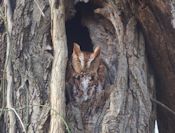 Eastern screech owl (Megascops Asia). Photo by Ed Eder.
Eastern screech owl (Megascops Asia). Photo by Ed Eder.
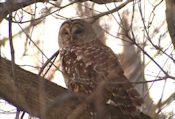 Barred owl. (Strix varia) Photo by Ed Eder.At least three species of owls have been observed in the Dyke Marsh Wildlife Preserve over the years – barred owl (Strix varia), Eastern screech owl (Megascops asio) and the great horned owl (Bubo virginianus).
Barred owl. (Strix varia) Photo by Ed Eder.At least three species of owls have been observed in the Dyke Marsh Wildlife Preserve over the years – barred owl (Strix varia), Eastern screech owl (Megascops asio) and the great horned owl (Bubo virginianus).
FODM President Glenda Booth has written an article in the January-February 2019 Virginia Wildlife magazine, titled “Virginia’s Most Mysterious Birds.” You can read the entire article here.
Butterfly and Host Plant Checklist for Dyke Marsh
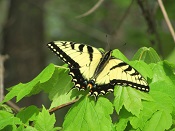 Eastern tiger swallowtail (Papilo glaucus). Photo by Glenda Booth
Eastern tiger swallowtail (Papilo glaucus). Photo by Glenda Booth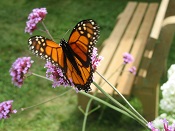 Monarch butterfly (Danaus plexippus). Photo by Glenda BoothButterfly checklist - Friends of Dyke Marsh volunteers conduct butterfly surveys from April to October every year. Working with staffers from the National Park Service, George Washington Memorial Parkway unit, we have prepared a butterfly checklist for our members and visitors. The checklist includes butterflies you could observe in Dyke Marsh and many of their host plants. Thank you to the following for helping produce this brochure: Jessica Strother, Jim Waggener, Mark Maloy and Brent Steury.
Monarch butterfly (Danaus plexippus). Photo by Glenda BoothButterfly checklist - Friends of Dyke Marsh volunteers conduct butterfly surveys from April to October every year. Working with staffers from the National Park Service, George Washington Memorial Parkway unit, we have prepared a butterfly checklist for our members and visitors. The checklist includes butterflies you could observe in Dyke Marsh and many of their host plants. Thank you to the following for helping produce this brochure: Jessica Strother, Jim Waggener, Mark Maloy and Brent Steury.
You can read the checklist here.
FODM Poster in a 2020 National Park Service Research Event
FODM participated in the National Park Service’s (NPS) Spotlight on Resources research conference on October 7 and 8, 2020. Jessica Strother and Bob Veltkamp prepared a poster describing our almost five years of volunteer surveys of dragonflies, damselflies and butterflies in Dyke Marsh. The poster, which includes 11 photographs, documents the species surveyed from 2016 through 2019: butterflies, 49 species; damselflies, 12 species; dragonflies, 36 species. Click here to view the poster. Our thanks to the dedicated volunteers and to NPS for the opportunity to share our work.
The Butterflies, Dragonflies and Damselflies of the Dyke Marsh Wildlife Preserve, 2016 to 2020
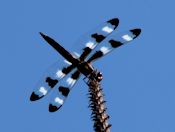 Twelve-spotted skimmer (Libellula pulchella). Photo by Kevin Munroe
Twelve-spotted skimmer (Libellula pulchella). Photo by Kevin Munroe Russet-tipped clubtail (Stylurus plagiatus). Photo by Kevin MunroeSince 2016, volunteers from FODM and the Audubon Society of Northern Virginia have conducted surveys of butterflies, dragonflies and damselflies in Dyke Marsh from April to October, led by Jim Waggener and Jessica Strother.
Russet-tipped clubtail (Stylurus plagiatus). Photo by Kevin MunroeSince 2016, volunteers from FODM and the Audubon Society of Northern Virginia have conducted surveys of butterflies, dragonflies and damselflies in Dyke Marsh from April to October, led by Jim Waggener and Jessica Strother.
2020 marked the fifth consecutive year. Their volunteer efforts built on previous surveys by Dr. Ed Barrows, Georgetown University, and Christopher Hobson, Virginia Department of Conservation and Recreation, Division of Natural Heritage in 2016.
The surveyors covered a defined area around the Belle Haven Marina and the Haul Road trail, using the same methodology each year, except in 2020, volunteers followed covid-19 pandemic protocols for their protection.
2020 Results
In 15 surveys totaling 33 field hours, the volunteers documented 33 butterfly species and 19 dragonfly species. They added two butterfly species to the previous list: the American snout (Libytheana carinenta) and the great spangled fritillary (Speryeria cybele). They added three species to the dragonfly/damselfly list: the twelve-spotted skimmer (Libellula pulchella), the shadow darner (Aeshna umbrosa) and the swift river cruiser (Macromia illinoiensis illinoiensis) .
A few highlights:
- Butterfly species outnumbered dragonflies (51 to 39), but far more individual dragonflies and damselflies were counted than butterflies.
- The group found new species each year.
- The group observed a more positive trend in monarch butterflies than in the first year of the survey, 2016.
- Species and overall numbers of dragonflies continue to decline.
To read the report covering all five years of surveys, click here. To see the species checklist showing species identified over the five years, click here. To reach the FODM butterfly and host plant checklist, click here.
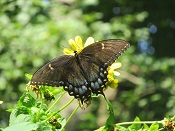 Eastern tiger swallowtail(Papilio glaucus), black form. Photo by Glenda BoothEditor’s note: FODM volunteers are working to control invasive plants and add more native plants, especially at the native plant site on the Haul Road trail. Insects and plants co-evolve and insects like butterflies depend on certain native or host plants for food and shelter. We assume that more aggressively controlling non-native plants like English ivy and porcelain berry could provide more support for native insects, like those that these surveys target.
Eastern tiger swallowtail(Papilio glaucus), black form. Photo by Glenda BoothEditor’s note: FODM volunteers are working to control invasive plants and add more native plants, especially at the native plant site on the Haul Road trail. Insects and plants co-evolve and insects like butterflies depend on certain native or host plants for food and shelter. We assume that more aggressively controlling non-native plants like English ivy and porcelain berry could provide more support for native insects, like those that these surveys target.
The Friends of Dyke Marsh send athank you to the following volunteers: Jim Waggener, Jessica Strother, Ed Eder, Larry Cartwright, Margaret Fisher, Joel Goldman, Su Kim, Joan Haffey, Ken Larsen, Joanne and Powell Hutton, Larry Meade, Rusty Moran, Gary Myers, Dave Nichols, Kristi Odom, Fred Siskind and Dixie Sommers. Thanks too to Brent Steury, George Washington Memorial Parkway, Natural Resources Program Manager.
The Dragonflies and Damselflies of the Dyke Marsh Wildlife Preserve, 2011 to 2019
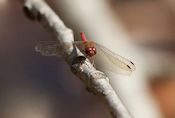 The autumn meadowhawk (Sympetrum vicinum ), our most cold-hardy dragonfly, perched near water on Haul Road. Photo by Ed EderFODM volunteers have conducted lepidoptera and odonata (butterflies, dragonflies and damselflies) surveys from April to October ever year since 2016. Here are the total species observed from 2016 to 2019: Butterflies - 49 species; Damselflies - 12 species; Dragonflies - 36 species.
The autumn meadowhawk (Sympetrum vicinum ), our most cold-hardy dragonfly, perched near water on Haul Road. Photo by Ed EderFODM volunteers have conducted lepidoptera and odonata (butterflies, dragonflies and damselflies) surveys from April to October ever year since 2016. Here are the total species observed from 2016 to 2019: Butterflies - 49 species; Damselflies - 12 species; Dragonflies - 36 species.
Chris Hobson, with the Virginia Department of Conservation and Recreation, Division of Natural Heritage, conducted a four-day field survey, sponsored by FODM, in 2011 by boat and on foot between May and September. Dr. Edd Barrows, a Georgetown University entomologist, has identified four additional species.
Hobson identified the following 16 species in 2011:
Common Green Darner (Anax junius), Orange Bluet (Enallagma signatum), Big Bluet (Enallagma durum), Prince Baskettail(Epitheca princeps), Common Pondhawk (Erythemis simplicicollis), Eastern Forktail (Ischnura verticalis), Fragile Forktail (Ischnura posita), Slaty Skimmer (Libellula incesta), Needham’s Skimmer (Libellula needhami), Great Blue Skimmer (Libellula vibrans), Wandering Glider (Pantala flavescens), Blue Dasher (Pachydiplax longipennis), Eastern Amberwing (Perithemis tenera), Common Whitetail (Plathymis lydia), Russet-tipped Clubtail (Stylurus plagiatus), Black Saddlebags (Tramea lacerate).
On July 22, 2013, Hobson added four more species to the survey:
Widow Skimmer (Libellula luctuosa), Twelve-spot Skimmer (Libellula pulchella), Halloween Pennant (Celithemis eponina), River Cruiser (Macromia sp.).
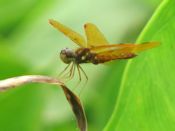 Male eastern amberwing (Perithemis tenera) perched on marsh vegetation. Photo by Christopher S. HobsonAny survey is a “snapshot” at a given time and place, not a comprehensive inventory. Total numbers seen on any day can vary tremendously, depending on the weather and time of year. Hobson saw more than 1,000 of one species in one day and hundreds of another during a short paddling trip, for example. His report notes that “there seems to be a core group of species that can be found consistently in and around the marsh” and that a number of other resident and migratory species could occur in the marsh.
Male eastern amberwing (Perithemis tenera) perched on marsh vegetation. Photo by Christopher S. HobsonAny survey is a “snapshot” at a given time and place, not a comprehensive inventory. Total numbers seen on any day can vary tremendously, depending on the weather and time of year. Hobson saw more than 1,000 of one species in one day and hundreds of another during a short paddling trip, for example. His report notes that “there seems to be a core group of species that can be found consistently in and around the marsh” and that a number of other resident and migratory species could occur in the marsh.
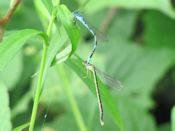 Big bluet (Enallagma durum) mated pair showing sexual dimorphism in both color and pattern. Photo by Christopher S. HobsonDragonflies and damselflies are in the order Odonata. These insects have two pairs of wings and three pairs of legs, among other characteristics. Dragonflies typically spread their wings to their sides when they land and are typically larger and more robust. Damselflies are usually smaller and they typically hold their wings together over their abdomen. Their eyes are separated. To identify specific species, experts study their wings, wing patterns, colors, tail, thorax, abdomen, genitalia and other features, some under a microscope. Some have bright, lustrous hues and diaphanous wings. Behavior is another important factor in identification of Odonata.
Big bluet (Enallagma durum) mated pair showing sexual dimorphism in both color and pattern. Photo by Christopher S. HobsonDragonflies and damselflies are in the order Odonata. These insects have two pairs of wings and three pairs of legs, among other characteristics. Dragonflies typically spread their wings to their sides when they land and are typically larger and more robust. Damselflies are usually smaller and they typically hold their wings together over their abdomen. Their eyes are separated. To identify specific species, experts study their wings, wing patterns, colors, tail, thorax, abdomen, genitalia and other features, some under a microscope. Some have bright, lustrous hues and diaphanous wings. Behavior is another important factor in identification of Odonata.
Dragonflies and damselflies are found around rivers, wetlands, seeps, bogs, springs, streams, ponds and lakes because their larvae, known as nymphs, are aquatic. Adults can be from half an inch to five inches long. Some species migrate south and return to Virginia in the spring. In Virginia, at least 194 species of dragonflies and damselflies have been identified. The best time to see them is from April to October.
Hobson submitted a report to FODM and to the National Park Service.
Plants of the Marsh
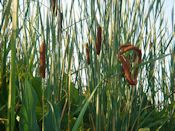
(Typha angustifolia L.)The dominant species of plant is the narrowleaf cattail, a plant more common to salty water. This plant typically develops its characteristic flower spike by June and releases seeds in the fall. Other species include arrowhead, arrow arum, pickerelweed, sweetflag, spatterdock and wild rice.
Unfortunately, many non-native plant species have been introduced into the area, plants that often outcompete beneficial native species. Examples are porcelainberry, Japanese honeysuckle, multi-flora rose and Asian bittersweet.
Saturday Morning Plant Walk in Dyke Marsh
 On a hazy Saturday morning on July 26, 2014, about 30 FODM members and friends turned out for a plant walk led by Dr. Elizabeth Wells (“Call me Beth”), Associate Professor Emerita of Botany at The George Washington University. Dr. Wells’s walks are always engaging and informative, and this one was no exception: the enthusiastic group observed a number of colorful and interesting plants. FODM President Glenda Booth provided the accompanying photos with essay by Pat Salamone.
On a hazy Saturday morning on July 26, 2014, about 30 FODM members and friends turned out for a plant walk led by Dr. Elizabeth Wells (“Call me Beth”), Associate Professor Emerita of Botany at The George Washington University. Dr. Wells’s walks are always engaging and informative, and this one was no exception: the enthusiastic group observed a number of colorful and interesting plants. FODM President Glenda Booth provided the accompanying photos with essay by Pat Salamone.

 The tropical-looking blossoms of the swamp rose mallow (Hibiscus moscheutos) are among the largest flowers produced by any perennial that is winter-hardy in our area. Dyke Marsh is home to two plants known as swamp dogwood, Cornus amomum and Cornus foemina, which are very similar in appearance. The blue berries of the swamp dogwood are eaten by several species of birds.
The tropical-looking blossoms of the swamp rose mallow (Hibiscus moscheutos) are among the largest flowers produced by any perennial that is winter-hardy in our area. Dyke Marsh is home to two plants known as swamp dogwood, Cornus amomum and Cornus foemina, which are very similar in appearance. The blue berries of the swamp dogwood are eaten by several species of birds.
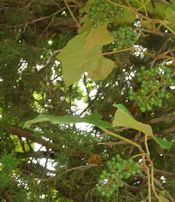

The native wild grape vine (Vitus L.) bears drooping clusters of fruit in the familiar bunch-of-grapes form.
Swamp milkweed (Asclepias incarnata) serves as a host plant for monarch butterfly caterpillars.
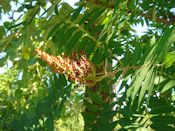
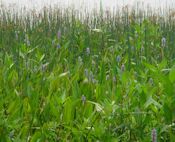 Smooth sumac (Rhus glabra) has compound pinnate (feather-like) leaves
Smooth sumac (Rhus glabra) has compound pinnate (feather-like) leaves
that turn red and orange in the fall, and bears clusters of small round red
fruits that serve as winter food for wildlife.
The purple flower spikes of pickerelweed (Pontederia cordata) are pollinator magnets.

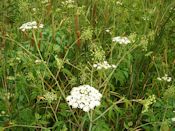 The tubers of the groundnut vine (Apios americana) were an important food source for many Native American tribes and some early European colonists. The vine bears clusters of beautiful reddish purple sweet-pea-like flowers.
The tubers of the groundnut vine (Apios americana) were an important food source for many Native American tribes and some early European colonists. The vine bears clusters of beautiful reddish purple sweet-pea-like flowers.
Although a member of the carrot family (Apiacieae) and looks similar to Queen Anne’s Lace, water hemlock (Cicuta maculata) is highly poisonous.

The tall coneflower or cutleaf coneflower (Rudbeckia laciniata) is recognized by pollination ecologists as attracting large numbers of native bees, according to The Xerces Society for Invertebrate Conservation.
Trying to Save Pumpkin Ash Trees
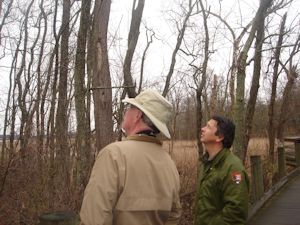 Robert Smith from FODM and Brent Steury from NPS were members of the project team that identified trees for treatment. Photo: G. Booth FODM is partnering with the National Park Service (NPS) on a project to try to save some of the preserve's pumpkin ash trees (Fraxinus profunda) from destruction by the emerald ash borer (EAB) (Agrilus planipennis), an invasive insect that was found in Fairfax County in 2003 and has been documented in Great Falls and Turkey Run Parks. "An EAB infestation is always fatal to ash trees," says the U.S. Department of Agriculture (USDA) website. The insect could kill all of the pumpkin ash trees in Dyke Marsh in 20 years without action.
Robert Smith from FODM and Brent Steury from NPS were members of the project team that identified trees for treatment. Photo: G. Booth FODM is partnering with the National Park Service (NPS) on a project to try to save some of the preserve's pumpkin ash trees (Fraxinus profunda) from destruction by the emerald ash borer (EAB) (Agrilus planipennis), an invasive insect that was found in Fairfax County in 2003 and has been documented in Great Falls and Turkey Run Parks. "An EAB infestation is always fatal to ash trees," says the U.S. Department of Agriculture (USDA) website. The insect could kill all of the pumpkin ash trees in Dyke Marsh in 20 years without action.
Dyke Marsh has over 1,000 pumpkin ash trees. These trees thrive in wet areas like swamps, floodplains and bottom lands, can reach 130 feet in height and have a 68-inch diameter. The pumpkin name comes from the trees' usually swollen or pumpkin-shaped butt or base.
Ensuring a Breeding Stock
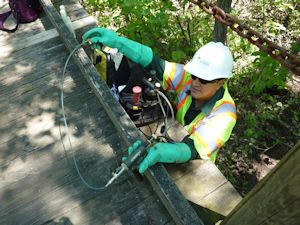 Lizardo Bonilla-Teza of Bartlett Tree Experts treated four trees on May 16, 2016. Photo by Robert Smith FODM's goal is to help NPS maintain a small, healthy breeding stock of these trees. In the spring of 2015, we contracted with Bartlett Tree Experts to conduct an insecticide treatment called Tree-age into the root flares of nine selected trees (Joshua Darkow applies treatment, photo left) in hopes that the treatment will kill any emerald ash borers infesting the trees. NPS chose a small group of trees located close together because ash trees have both male and female flowers and are air pollinated. NPS also tagged and wrapped the trees with beaver-resistant netting. Bartlett's Joshua Darkow injected the trees on May 13. If the treated trees remain healthy for two years, we hope to repeat treatments until the EAB infestation has passed through our area. There is no guarantee that the treatment will be successful.
Lizardo Bonilla-Teza of Bartlett Tree Experts treated four trees on May 16, 2016. Photo by Robert Smith FODM's goal is to help NPS maintain a small, healthy breeding stock of these trees. In the spring of 2015, we contracted with Bartlett Tree Experts to conduct an insecticide treatment called Tree-age into the root flares of nine selected trees (Joshua Darkow applies treatment, photo left) in hopes that the treatment will kill any emerald ash borers infesting the trees. NPS chose a small group of trees located close together because ash trees have both male and female flowers and are air pollinated. NPS also tagged and wrapped the trees with beaver-resistant netting. Bartlett's Joshua Darkow injected the trees on May 13. If the treated trees remain healthy for two years, we hope to repeat treatments until the EAB infestation has passed through our area. There is no guarantee that the treatment will be successful.
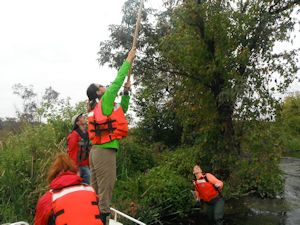 Four staffers from the North Carolina Botanic Garden helped NPS and FODM collect pumpkin ash seeds in September. Credit: Robert Smith In September, four North Carolina Botanic Garden staff members, with the assistance of Peter McCallum and Brent Steury from NPS and Robert Smith from FODM, collected pumpkin ash seeds in Dyke Marsh for preservation. They met their goal of 10,000 or more seeds from 25 or more trees. These seeds will be available in the future to help in the marsh's restoration and to replace trees expected to be lost to the EAB.
Four staffers from the North Carolina Botanic Garden helped NPS and FODM collect pumpkin ash seeds in September. Credit: Robert Smith In September, four North Carolina Botanic Garden staff members, with the assistance of Peter McCallum and Brent Steury from NPS and Robert Smith from FODM, collected pumpkin ash seeds in Dyke Marsh for preservation. They met their goal of 10,000 or more seeds from 25 or more trees. These seeds will be available in the future to help in the marsh's restoration and to replace trees expected to be lost to the EAB.
On May 16, 2016, with support from FODM and NPS, Bartlett Tree Experts treated another four pumpkin ash trees for the emerald ash borer. At that time, there were many dead trees, presumably because of this non-native insect. “Significant numbers of ash trees along the George Washington Memorial Parkway and in Dyke Marsh have failed to leaf out this spring,” said FODM project manager Robert Smith, “presumably due to the emerald ash borer. However, the nine trees we treated last spring are all in good shape.” He added, “Adding these trees to the initial group will greatly enhance the chances that we will be able to maintain a healthy set of pumpkin ash trees in the marsh. Hopefully, they will be able to both propagate themselves and provide seeds for use in the restoration.”
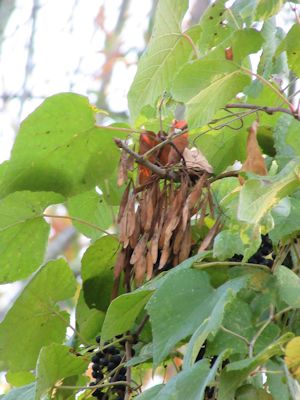 FODMers observed seeds on many treated trees in September 2017. Referring to the trees treated in 2015, NPS Biologist Brent Steury said,” The first nine trees were obviously much healthier than any other ash trees in the area except the four I selected for treatment in this round.”
FODMers observed seeds on many treated trees in September 2017. Referring to the trees treated in 2015, NPS Biologist Brent Steury said,” The first nine trees were obviously much healthier than any other ash trees in the area except the four I selected for treatment in this round.”
“Most of the surrounding ash trees are dead with one notable exception and that is a female at the far southeastern edge of the copse that also produced plenty of seeds. Of the study trees, three showed some significant bare areas ranging from approximately 25 percent to 40 percent of the branch area, but this does not indicate a fatal emerald ash borer infestation. Two of these trees were added in 2017 and showed some bare areas at the time of treatment but were determined worth trying to save.”
On September 25, 2017, five FODMers and Brent Steury with the National Park Service surveyed the treated trees in Dyke Marsh. Project leader Robert Smith wrote, “It was very encouraging to see that all of these trees had leafed out this season and that all six of the females had produced plenty of seeds. Six of the trees were originally treated in 2015, four more were treated in 2016 thanks to a dedicated donation, and six more were added by NPS in 2017 and all 16 were treated this spring with NPS funding (mitigation for three that were accidentally removed last year).
On April 11, 2019, FODM and National Park Service (NPS) employees revisited the pumpkin ash preservation site. FODM will finance the treatment of two more trees in May 2019.
In preparation for the treatment, Brent Steury, NPS Natural Resources Manager, Stephen Fagin, NPS Horticulturist, and Robert Smith, FODM Project Manager, surveyed the 16 study trees. They also wrapped trees with wire mesh to prevent beavers from chewing them down and tagged two trees for probable addition to this year’s treatment program. They took diameter measurements, put fresh orange ribbons on the study trees and did some minor clearing of invasive plants.
The success of this project is unknown. The emerald ash borer usually kills the trees it infects. It is too early in the year and in the study to draw any firm conclusions about the treatment’s effect or the health of the trees.
"It is painful to imagine Dyke Marsh without its expanse of ash trees so we are doing what we can to ensure that they will revive after an attack," said Robert Smith, FODM project manager. Photos courtesy of Glenda Booth.
|
|
|
|
Destabilizing an Unstable Marsh
Dead trees and fewer trees in the marsh would further destabilize Dyke Marsh, NPS officials maintain. Dyke Marsh is already eroding 1.5 to two acres a year and will be gone in 20 years without action, concluded the U.S. Geological Survey in a 2010 study. Dredging of the marsh from 1940 to 1972 destabilized the marsh. USGS concluded that Dyke Marsh "has shifted from a semi-stable net depositional environment (1864-1937) into a strongly erosional one . . . The marsh has been deconstructed over the past 70 years by a combination of manmade and natural causes."
The Metallic Green Invader
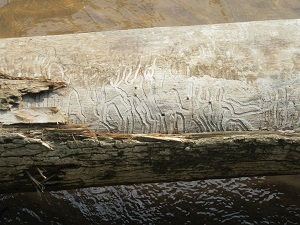 This dead log, which washed up on the shoreline in Dyke Marsh, shows how the emerald ash borer bores "tunnels" in trees and ultimately kills the tree. Credit: Glenda Booth
This dead log, which washed up on the shoreline in Dyke Marsh, shows how the emerald ash borer bores "tunnels" in trees and ultimately kills the tree. Credit: Glenda Booth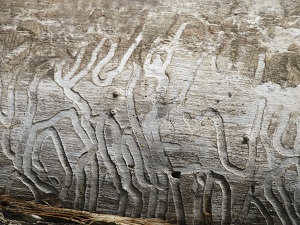 Close-up of emerald ash borer tunnels. Credit: Glenda Booth EAB is a metallic green, wood-boring beetle from Asia, one-half inch long and one-eighth inch wide. Experts believe it probably came to the U.S. in wood packaging material.
Close-up of emerald ash borer tunnels. Credit: Glenda Booth EAB is a metallic green, wood-boring beetle from Asia, one-half inch long and one-eighth inch wide. Experts believe it probably came to the U.S. in wood packaging material.
From May to August, adult EABs emerge from winter hibernation and mate. EAB females can lay up to 200 eggs in the beetle's lifetime. They deposit the eggs in bark crevices or under bark flaps. After the eggs hatch, larvae chew through the bark and tunnel into the phloem and cambial region of the tree. The wormlike larvae feed on the inner bark and disrupt the tree's ability to transport water and nutrients. They create squiggly, serpentine patterns called "galleries." In late spring, adults emerge through a four millimeter, D-shaped hole. The D-shaped hole is a telltale sign of the EAB.
Devastation
All species of ash are at risk, reports USDA, as what's been called "the green menace" creeps across the land. Tens of millions of trees have already died or are heavily infested in the U.S. and Canada. A tree's decline is gradual. A USDA map https://www.aphis.usda.gov/plant_health/plant_pest_info/emerald_ash_b/downloads/AshRangeMap.pdf) shows the insect's presence in most states east of the Mississippi River.
EAB infestations are difficult to detect. Woodpeckers feeding on dead branches near the tree's top could be a sign of an infestation. Woodpeckers are natural predators, but unfortunately, they have not prevented many trees from dying or slowed the pest's spread.
Virginia is under a federal EAB quarantine which prohibits the interstate movement of certain articles including ash logs, ash nursery stock , lumber, firewood and any other ash material, living, dead, cut or fallen, including logs, stumps, branches, roots and composted and uncomposted chips from any species of ash.
For more information, visit www.emeraldashborer.info/, http://www.mountvernongazette.com/news/2020/oct/31/baseball-bats-and-ash-trees-face-uncertain-fate/ and www.vainvasivespecies.org/species/emerald-ash-borer
The Marsh Wren -- Loss of Habitat, Loss of Birds
by Glenda C. Booth
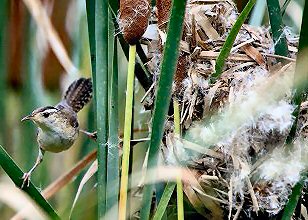 Marsh Wren (Cistothorus palustrus)
Marsh Wren (Cistothorus palustrus)
Photo by Ed EderIt’s a little brown bird that lives in marsh cattails, bulrushes or cordgrass, and known for its calls. Some people hear a rusty hinge. Others say it’s a sputtering, bubbling trill. Other fans liken the call to a clattering sewing machine, a guttural rattle or a liquid gurgle, ending in chatter. It can be a loud little bird, especially on a spring night.
It is the marsh wren (Cistothorus palustris), once a common bird in the Dyke Marsh Wildlife Preserve. The Dyke Marsh Wildlife Preserve today supports the only known nesting population of marsh wrens in the upper Potomac River tidal zone.
National Park Service biologist Brent Steury wrote, “Marsh wrens are cute little brown-eyed birds not much over five inches long and weigh in at about half an ounce. Their dark brown cap rests atop a bold white supercilium, or eyebrow, that broadens as it extends from the base of the bill to the base of the neck. The body is chestnut, with a black, white streaked cape over the shoulders. The throat is nearly white and the belly pale buff. Sexes are identical. Active and noisy, they flutter rapidly among the cattails, often observed when perched with splayed legs, each foot tightly clasping a separate stem, bill agape in loud unmistakable song.” They usually hold their tails upright or often almost laying on the back, a distinctive trait.
Marsh wrens breed in fresh and brackish marshes, usually in areas of dense, reedy vegetation. They construct elaborate football-shaped nests with round openings by weaving grasses or cattail leaves in a circular manner anchored to reeds or cattails a few feet above the water. The male builds several “dummy nests” nearby, presumably to trick predators.
Seeing a marsh wren can be challenging, except during the breeding season, when males perform aerial displays before alighting on singing perches on the perimeters of their claimed breeding territories or when building one of their dummy nests. They often flit around furtively, popping up now and then to look around.
A Steady, Sad Decline
The Dyke Marsh Wildlife Preserve was once popping with marsh wrens. In the late 1800s, observers reported of hundreds of globular marsh wren nests affixed to reeds in the wetlands that lined the Potomac River, wetlands now largely gone.
Louis Halle, who biked from Washington, D.C., to Dyke Marsh, extolled this little bird in his 1947 Spring in Washington: “We heard the wrens this morning before there was light to see them. All over the marshes we heard them, singing in a steady chorus, each song a gurgling chatter, brief but repeated with hardly time for breath between. When it became light enough, we saw the singing wrens as far as the eye could reach over the marshes, carried upward on fluttering wings above the grass-tops by the very exuberance of their song, and sinking back again. The dots were bobbing up and down everywhere, like a natural effervescence given off by the marsh.”
In 1950, surveyors counted 87 singing males in Dyke Marsh. "Thirty-one territories were located in 1998 and 34 in 1999. The minimum estimated population size for 1998 was 38 (34 territorial males and seven breeding females); and for 1999, 48 (34 territories males and 14 breeding females)," wrote Sandy C. Spencer in her 2000 master’s degree thesis for George Mason University. (Spencer is now Supervisory Wildlife Biologist at the Patuxent Research Refuge.)
In 2007, surveyors found six established territories; in 2008, 10 breeding pairs; in 2010 and 2011, 12 established territories, but in these years, surveyors probably did not cover the same areas. In the 2012 survey, Larry Cartwright, head of FODM’s annual breeding bird survey, confirmed only two active nests and reported that surveyors saw or heard eight territorial males and possibly two to four more, conservative estimates he believes. Surveyors have not confirmed any breeding marsh wrens since 2014, a very troubling trend.
“The fate of marsh wrens and least bitterns remain in doubt at Dyke Marsh, but the trend suggests eventual disappearance for at least the marsh wren,” Cartwright contends.
As Dyke Marsh erodes away, a major factor in the marsh wren’s decline is loss of habitat. Spencer offered this guidance in 2000: “Available habitat comprises only 12 percent of the entire preserve, but actual use by marsh wrens for nesting territories was only 3.6 percent in 1999, because of very narrow habitat selection preferences (tall, dense, emergent vegetation adjacent to water). Protection of the remaining habitat from reduction or degradation due to expansion of invasive plants and erosion and restoration of lost habitat are strongly recommended to ensure persistence of this population over the long term.”
Students Produce Video about Dyke Marsh
by Cece Brower
From April to June, 2015, I had a English-history-chemistry assignment at Thomas Jefferson (TJ) High School for Science and Technology to create a documentary about a local environmental issue involving chemistry. My group chose to address the restoration of the Dyke Marsh wetland because it's an important project that affects our community and the health of the Potomac River. We thought it would be interesting to make our documentary child friendly, so we chose to use a puppet approach.
The other students who worked on it were Leela Ramineni, Ragavi Murali and Tatiana Bennett. We were all sophomores at TJ when we did the project. Tatiana now goes to Stone Ridge School.
Raptor Rapture
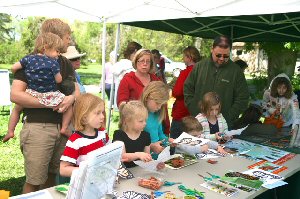 Children enjoyed interactive participation at the Earth Day event on April 20. Photo by Ed Eder.Around 300 people came out on April 20 to learn about raptors.
Children enjoyed interactive participation at the Earth Day event on April 20. Photo by Ed Eder.Around 300 people came out on April 20 to learn about raptors.
To celebrate Earth Day, the Friends of Dyke Marsh, the Monarch Teacher Network, the National Park Service and the Raptor Conservancy of Virginia (RCV) set up an exhibit in Belle Haven Park 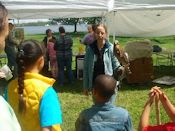 Youngsters of all ages were captivated by the display of raptors. Photo by G. Booth.from 10 a.m. to 12 noon near the bicycle path.
Youngsters of all ages were captivated by the display of raptors. Photo by G. Booth.from 10 a.m. to 12 noon near the bicycle path.
Kent Knowles and Gabby Hrycyshyn of RCV introduced visitors to birds of prey – a barred owl, an Eastern screech owl, a peregrine falcon hybrid, a red-shouldered hawk and a red-tailed hawk. RCV rehabilitates injured raptors and then releases those that can survive on their own.
For more information on their work, visit their website www.raptorsva.org.
Through conservation and education, FODM works to support raptors and other wildlife and their habitat.
2015 Frog Survey and Frog Calls
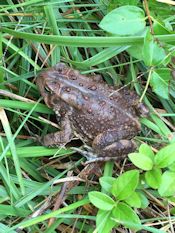 American toad (Anaxyrus americanus)Laura Sebastianelli led the first known citizen monitoring program in Dyke Marsh West from March to August after launching our own FrogWatch USA chapter early in 2015. She heard and documented six species. "The songs of spring peepers, American toads and especially green tree frogs were pleasant surprises," she wrote in our fall newsletter, The Marsh Wren.
American toad (Anaxyrus americanus)Laura Sebastianelli led the first known citizen monitoring program in Dyke Marsh West from March to August after launching our own FrogWatch USA chapter early in 2015. She heard and documented six species. "The songs of spring peepers, American toads and especially green tree frogs were pleasant surprises," she wrote in our fall newsletter, The Marsh Wren.
Surveyors Gray tree frog (Hyla versicolor) and Cope's Gray Tree Frog (Hyla chrysoscelis) look identical but can be differentiated by their call. focused on Dyke Marsh West because some River Towers Condominiums residents expressed concerns about what appeared to be declining frog species over the past several years. They said, for example, that they still heard bullfrogs and green frogs, but they no longer heard spring peepers, American toads, wood frogs or gray tree frogs. Experts say it is not unusual for amphibian populations to rise and fall. Worldwide, scientists have documented an overall decline.
Gray tree frog (Hyla versicolor) and Cope's Gray Tree Frog (Hyla chrysoscelis) look identical but can be differentiated by their call. focused on Dyke Marsh West because some River Towers Condominiums residents expressed concerns about what appeared to be declining frog species over the past several years. They said, for example, that they still heard bullfrogs and green frogs, but they no longer heard spring peepers, American toads, wood frogs or gray tree frogs. Experts say it is not unusual for amphibian populations to rise and fall. Worldwide, scientists have documented an overall decline.
Laura shared these observations: "Beginning in early April, I heard a lone spring peeper frequently on the grounds of River Towers Condos for over a month. While I heard only one voice calling from the same location, not far away, in Belleview Elementary School's wetland meadow, a small chorus of spring peepers began calling in late March. Their songs carry a significant distance and combined with the knowledge that peepers have been documented to migrate up to two miles for breeding, the song of the lone spring peeper at River Towers became a song of hope. Describing the sound of spring peepers in years past as 'delightfully deafening,' residents had not recalled hearing a spring peeper in at least three years. In May, we regularly heard a lone American toad for weeks. 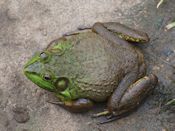 American bullfrog (Lithobates catesbeianus)In June, we documented a gray tree frog. These were welcomed songs that most people have not heard for at least three years. While focused on Dyke Marsh West, the surprise of the season was Ed Eder's hearing a green tree frog near the Haul Road, not part of our 2015 study area."
American bullfrog (Lithobates catesbeianus)In June, we documented a gray tree frog. These were welcomed songs that most people have not heard for at least three years. While focused on Dyke Marsh West, the surprise of the season was Ed Eder's hearing a green tree frog near the Haul Road, not part of our 2015 study area."
Volunteers Identify 16 Herptofauna, Two New Species in DMWP
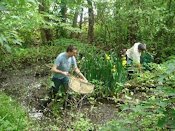 Matthew Neff and Alonso Abugattas search for herps. Photo by Greg Crider.
Matthew Neff and Alonso Abugattas search for herps. Photo by Greg Crider. Charles Smith (looking at a field guide to correctly identify the turtle), and Nicole Reintsma is holding the turtle she found. Photo by Greg Crider.Forty enthusiastic volunteers conducted a herpetology survey in the Dyke Marsh Wildlife Preserve on May 3, 2012, an effort sponsored by the Virginia Herpetological Society, the Friends of Dyke Marsh and the U.S. National Park Service (NPS). Herpetology, a branch of zoology, is the study of amphibians (like frogs, toads, salamanders and newts) and reptiles (like snakes, lizards, turtles and terrapins). Herpetology is derived from Greek words meaning the “knowledge of crawling things.” Volunteers looked under logs and rocks, poked in the leaf litter and searched through brush piles. Some herpers explored the flotsam and trash along the shoreline.
Charles Smith (looking at a field guide to correctly identify the turtle), and Nicole Reintsma is holding the turtle she found. Photo by Greg Crider.Forty enthusiastic volunteers conducted a herpetology survey in the Dyke Marsh Wildlife Preserve on May 3, 2012, an effort sponsored by the Virginia Herpetological Society, the Friends of Dyke Marsh and the U.S. National Park Service (NPS). Herpetology, a branch of zoology, is the study of amphibians (like frogs, toads, salamanders and newts) and reptiles (like snakes, lizards, turtles and terrapins). Herpetology is derived from Greek words meaning the “knowledge of crawling things.” Volunteers looked under logs and rocks, poked in the leaf litter and searched through brush piles. Some herpers explored the flotsam and trash along the shoreline.
By day’s end, the group had identified 16 species. “The May 3 effort added two new records, the non-native yellow-bellied slider and eastern king snake,” concluded NPS’s Brent Steury, Natural Resources Program 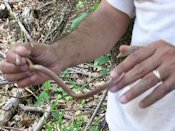 Worm Snake (Carphophis amoenus) about 10 inches long. Photo by Greg Crider.Manager for the George Washington Memorial Parkway. “Any time we add a new species, especially a vertebrate to the thousands of species previously recorded from the George Washington Memorial Parkway, we add a missing piece to the puzzle of biological diversity that exists in Northern Virginia.” Alonso Abugattas, Manager of Arlington’s Long Branch Nature Center, commented, “The information is important for the park and its managers because you can't protect or manage what you don't know you have or what's in trouble.” The survey had three segments: 10 a.m. to 1 p.m. on land, in four different areas; 2 to 5 p.m. on water; and 8 to 9:15 p.m. on land to listen for frogs calling.
Worm Snake (Carphophis amoenus) about 10 inches long. Photo by Greg Crider.Manager for the George Washington Memorial Parkway. “Any time we add a new species, especially a vertebrate to the thousands of species previously recorded from the George Washington Memorial Parkway, we add a missing piece to the puzzle of biological diversity that exists in Northern Virginia.” Alonso Abugattas, Manager of Arlington’s Long Branch Nature Center, commented, “The information is important for the park and its managers because you can't protect or manage what you don't know you have or what's in trouble.” The survey had three segments: 10 a.m. to 1 p.m. on land, in four different areas; 2 to 5 p.m. on water; and 8 to 9:15 p.m. on land to listen for frogs calling.
Click here to read the survey report by the survey's leader, Caroline Seitz.
Research on Sediment Dynamics in Dyke Marsh
Many of us have wondered, "Is the marsh growing or shrinking? Is it being rebuilt by the river, or are we losing it to erosion?" To provide some answers to these questions, research in the gain and loss of sediments in the marsh has been undertaken by Cindy Palinkas and David Walters of the Horn Point Laboratory of the University of Maryland Center for Environmental Science in Cambridge, MD, in cooperation with the National Park Service, building on earlier work by Katia Engelhardt. They reported their work in a poster paper at a recent conference of the American Geophysical Union. The goal of their study is more modest than predicting the ultimate fate of the marsh: "to better understand the spatial and temporal variability in sedimentary processes in a freshwater tidal marsh." There are competing effects at work in setting the level of the marsh relative to the river. The Potomac always carries a burden of sediment, which is greatly enhanced following heavy rain upstream. Two daily incoming tides flood parts of the marsh, and some of the river-borne sediment is left behind in those areas.
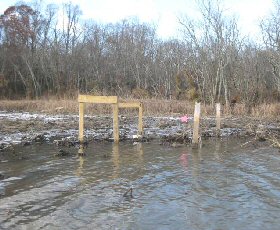 A Surface Elevation Table used to evaluate gain or loss of sediments. Photo by Ned Stone.Some weather conditions can produce unusually high water levels, bringing sediments onto higher ground. On the other hand, heavy rain in the local area can produce strong outflows, and will wash some of this sediment back out. Also working against building up the marsh are two long-term effects: sea level rise and the general subsidence of the entire Maryland-Virginia area. Several different techniques are involved in evaluating the gain or loss of sediments. One, deployed by the National Park Service, is called a SET (Surface Elevation Table) (see photo). Researchers have installed a dozen of these in the marsh in the last decade. Other techniques involve collecting deposits on ceramic tiles and radioisotope sampling as a function of depth. These measurements were made at approximately 24 sites in locations throughout the marsh. Results on several time scales - month, season, year, and decade - are presented in the paper. This research by Palinkas and Walters is not yet complete. Also, the sediment results vary considerably from place to place in the marsh. For those reasons, it is not yet possible to draw any firm conclusions about gain and loss over the whole marsh. Reading their report, however, suggests that while the marsh is generally gaining in deposited sediments, it may nonetheless be losing to subsidence.
A Surface Elevation Table used to evaluate gain or loss of sediments. Photo by Ned Stone.Some weather conditions can produce unusually high water levels, bringing sediments onto higher ground. On the other hand, heavy rain in the local area can produce strong outflows, and will wash some of this sediment back out. Also working against building up the marsh are two long-term effects: sea level rise and the general subsidence of the entire Maryland-Virginia area. Several different techniques are involved in evaluating the gain or loss of sediments. One, deployed by the National Park Service, is called a SET (Surface Elevation Table) (see photo). Researchers have installed a dozen of these in the marsh in the last decade. Other techniques involve collecting deposits on ceramic tiles and radioisotope sampling as a function of depth. These measurements were made at approximately 24 sites in locations throughout the marsh. Results on several time scales - month, season, year, and decade - are presented in the paper. This research by Palinkas and Walters is not yet complete. Also, the sediment results vary considerably from place to place in the marsh. For those reasons, it is not yet possible to draw any firm conclusions about gain and loss over the whole marsh. Reading their report, however, suggests that while the marsh is generally gaining in deposited sediments, it may nonetheless be losing to subsidence.
Learn More About DMWP’s Complex Biodiversity
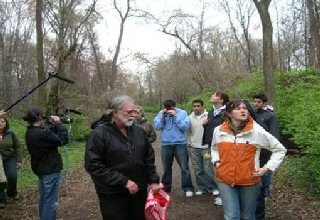 Dr. Edd Barrows leads students in study along Haul Road in Dyke Marsh. Photo by Robert Smith. An excellent website for learning about the many natural resources of Dyke Marsh Wildlife Preserve (DMWP) is the Biodiversity Database of the Washington, D.C., Area (BDWA), produced by Professor Dan Kjar of Elmira College and Professor Edd Barrows of Georgetown University’s Laboratory of Entomology and Biodiversity. The BDWA has arthropod lists and photographs of many DMWP organisms, provides
Dr. Edd Barrows leads students in study along Haul Road in Dyke Marsh. Photo by Robert Smith. An excellent website for learning about the many natural resources of Dyke Marsh Wildlife Preserve (DMWP) is the Biodiversity Database of the Washington, D.C., Area (BDWA), produced by Professor Dan Kjar of Elmira College and Professor Edd Barrows of Georgetown University’s Laboratory of Entomology and Biodiversity. The BDWA has arthropod lists and photographs of many DMWP organisms, provides
helpful links and lists some publications related to the Preserve.
To access DMWP information, visit the Biodiversity Database website.
Dr. Barrows wrote in the spring 2008 Marsh Wren, the newsletter of the Friends of Dyke Marsh, that there are thousands of “key players” in the wetland’s ecosystem, yet to be studied and recorded.
About invertebrates (including arthropods), BDWA quotes Professor Edward O. Wilson: "The truth is that we need invertebrates but they don’t need us. If human beings were to disappear tomorrow, the world would go on . . . . But if invertebrates were to disappear; I doubt that the human species could last more than a few months. Most of the fishes, amphibians, birds and mammals would crash to extinction about that same time. Next . . . the bulk of the flowering plants . . . and the world would return to the state of a billion years ago. . . ."
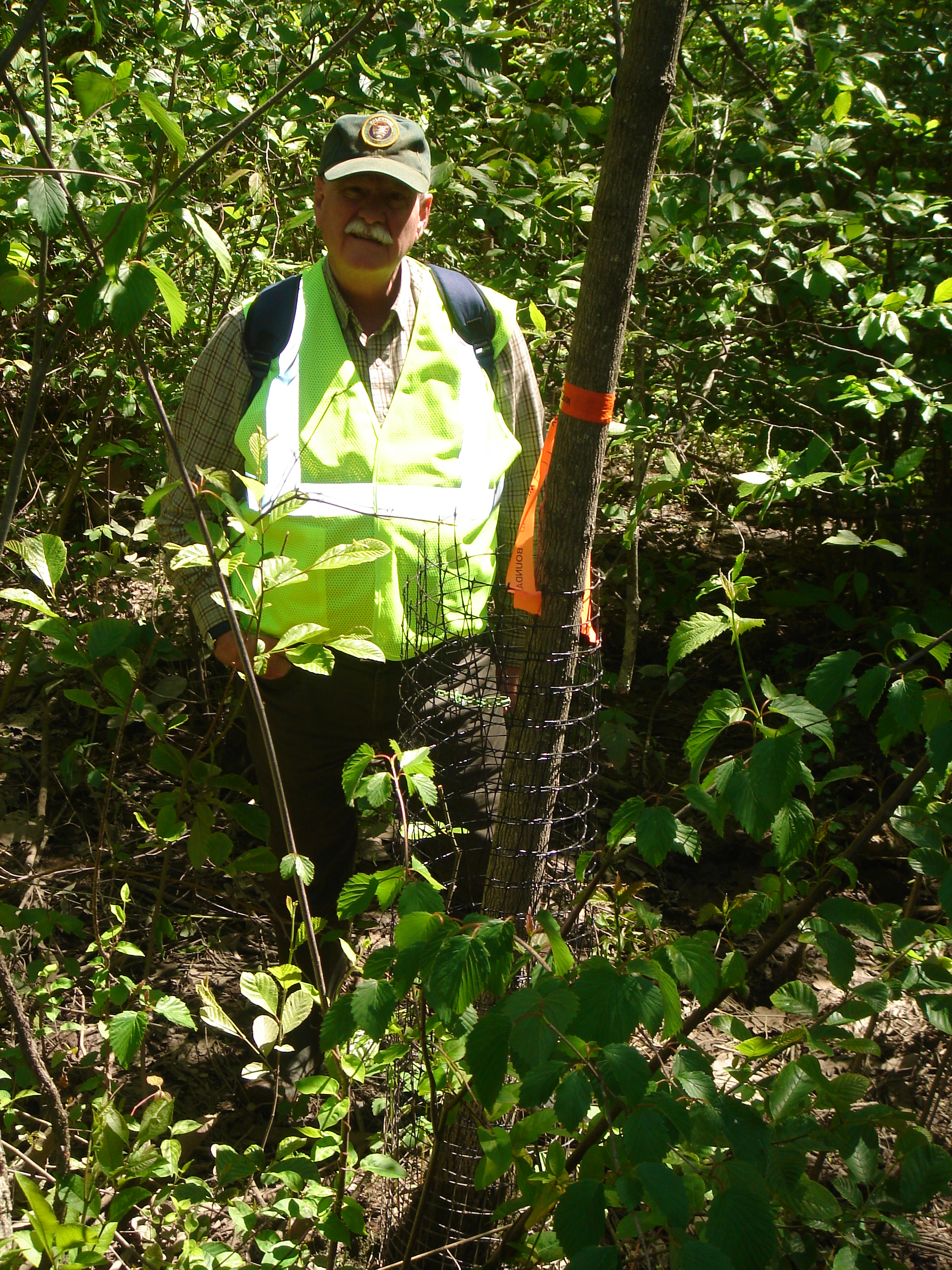
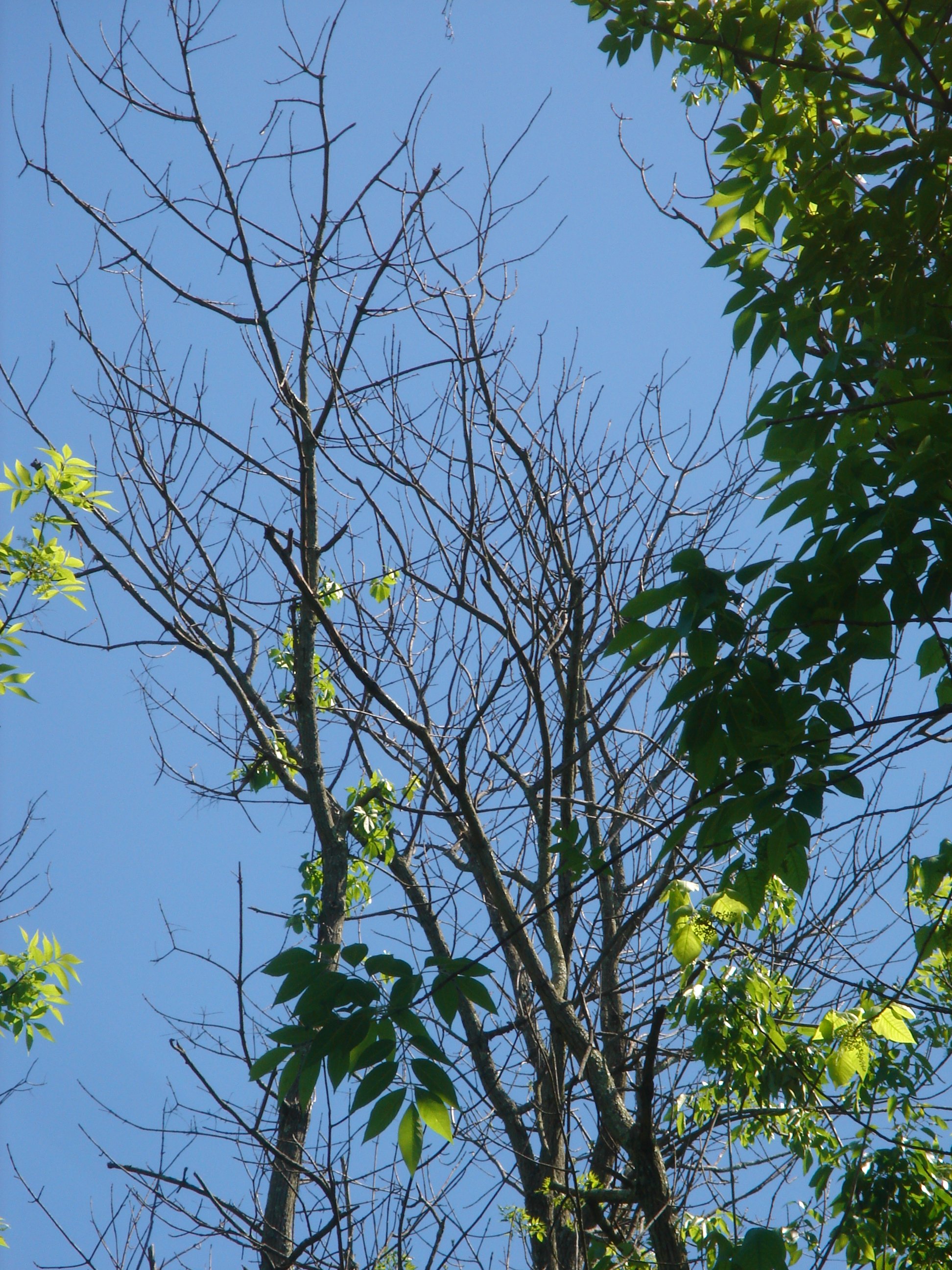
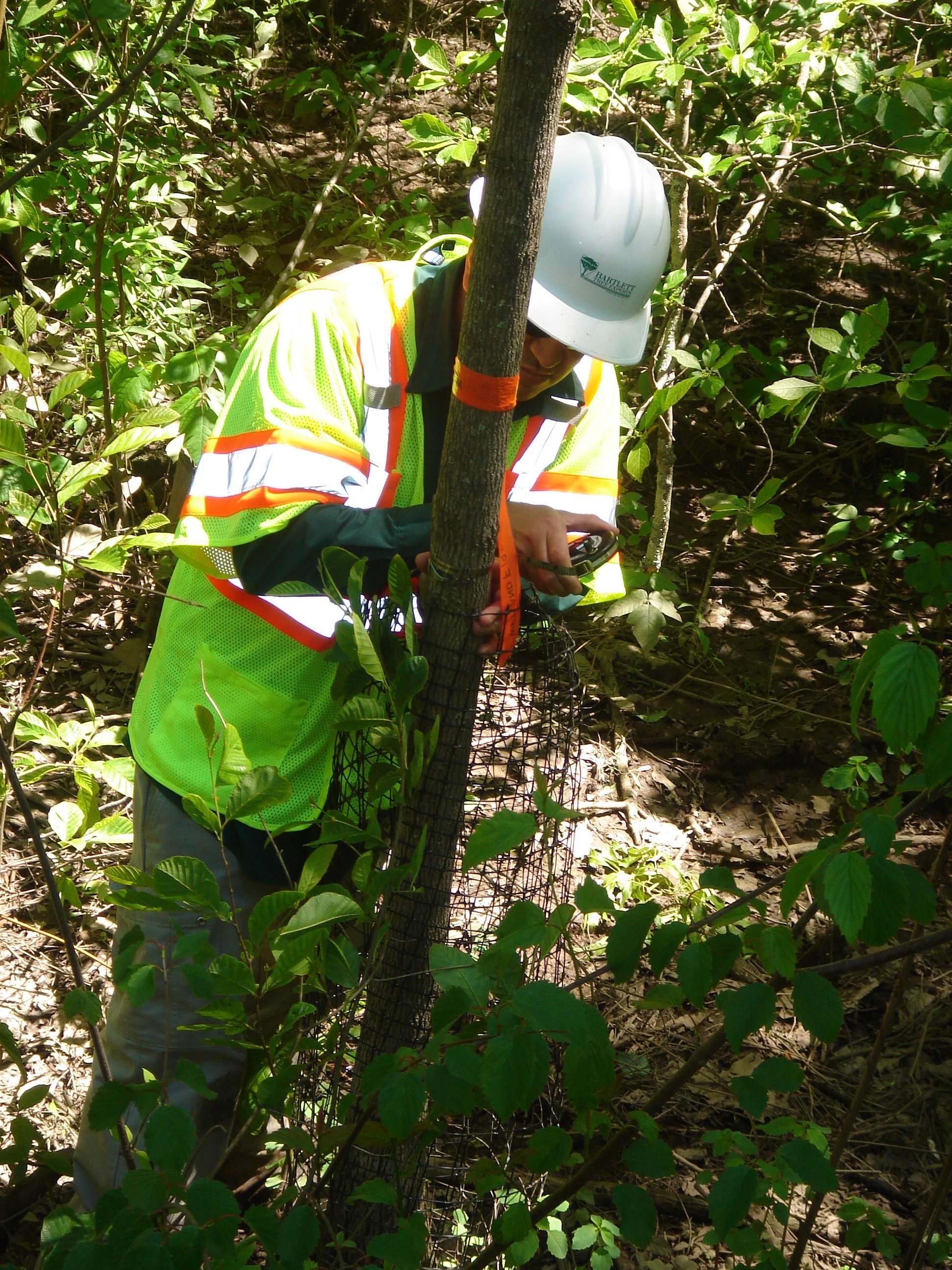

 Friends of Dyke Marsh, Inc. is a non-profit 501(c)(3) organization.
Friends of Dyke Marsh, Inc. is a non-profit 501(c)(3) organization.